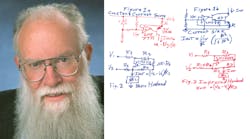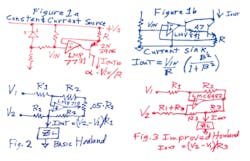Download Volume 3 of the Bob Pease eBook series.
Recently, a guy asked me how to draw a constant 1.00 mA from a node of a circuit. Of course, he did not tell me what volts, ohms, or frequency. But, he admitted, he basically did not know how to design a current source.
So I’m sorry to waste the time of all you guys who do know how to design a current-source. But maybe this lecture can help and save you some time so you don’t have to teach all the young kids. If you need a current source, and you don’t know where to look, it is not easy to find advice on how to make them. I looked and could not find valid advice on how to do this! So, here you go.
Editor's Note: The video is one of The Bob Pease Show episodes that was recorded in the same general timeframe.
Figure 1 is a basic (unidirectional) current source that can spit out any positive current you want. You want 10 or 100 µA? 10 or 100 mA? 10 or 100 nA? 10 or 100 A? Be my guest. It does a good job, putting out current in one direction—but not both.
The current sourced is I = VIN/R (Fig. 1a). Of course, you need an op amp whose common-mode (CM) range extends to the right voltage and whose IB is small enough. For current sourcing, you need an amplifier whose CM range and output go approximately to the positive rail, and you need PNP transistors. Sometimes you can arrange it so the output does not have to go too close to the rail, using a resistive divider. The transistor is shown in a nominal way.
For 1-mA full-scale current, an ordinary 2N3906 can give you a ZOUT of 50 MΩ. If you want a really high ZOUT, like 1000 M Ω, you might put in a Darlington (Fig. 1b). Or for large currents, a Trarlington could be justified. If you need to put current into a fast-moving signal, you might need to add some extra cascoding to IOUT.
For sinking current, you need an amplifier whose CM range (and output swing) extends to (or near) ground, or –VS (Fig. 1b). And, you need an NPN transistor. This is often called a constant current source.
Well, it does not have to be absolutely “constant.” It can be “modulated” or adjusted by changing the VIN. You could put in some ac. But don’t allow the current to get “modulated” to zero, or you might get some strange response from the unhappy amplifier.
A Howland current pump can put out positive or negative current—or zero (Fig. 2). Then there is the “improved” Howland current pump (Fig. 3). Both are wonderful when you have defined what ranges of V and I you want. Neither one has a great weakness, depending on what you want. If you want the output to go close to the rails, the “improved” Howland can usually be arranged to swing closer.
Some Extra Info I recently did a complete analysis of the Howland circuits, and I wrote it up as an Application Note, AN-1515, at www.national.com/an/AN/AN-1515.pdf. I included some notes on trimming the resistors, because many times the Howland is just presented as a nominal circuit, with no trimming indicated. But to get high ZOUT, you usually do have to trim.For a 1-mA output (all R’s = 10k ±1%), the ZOUT might be as poor as 0.25 MΩ, +0.25 MΩ or even –0.25 MΩ. So, you have to trim. (See the little trim on Figure 2. Even 0.1% resistors would only provide a moderate improvement, to ±2.5 MΩ.) That App Note also shows how to get high ZOUT without any pots.
Comments invited!
[email protected] —or: Mail Stop D2597A, National Semiconductor P.O. Box 58090, Santa Clara, CA 95052-8090


